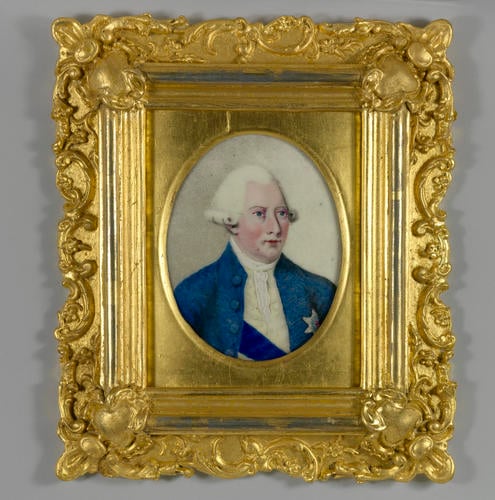-
1 of 253523 objects
George III (1738-1820) after Zoffany c.1771-80
Enamel | 9.5 x 7.5 cm (sight) (sight) | RCIN 421117
-
George III is wearing the ribbon and star of the Order of the Garter. The portrait may have been painted from life but Princess Amelia, who painted the miniature, is likely to have looked at Johan Zoffany's portrait of her father of 1771 (RCIN 405072).
George III was born on 4 June 1738, the eldest son of Frederick, Prince of Wales, and Princess Augusta of Saxe-Gotha. He became heir to the throne on the death of his father in 1751, succeeding his grandfather, George II, in 1760. He was the third Hanoverian monarch and the first one to be born in England and to use English as his first language. When he succeeded to the throne, George III proclaimed to Parliament, 'I glory in the name of Briton'. In 1761, he married Princess Charlotte of Mecklenburg-Strelitz and the following year bought the Queen's House for her, later enlarged to become Buckingham Palace. They had 15 children. George was greatly interested in all branches of art and science. He was taught architecture by William Chambers and commissioned highly sophisticated clocks, barometers and watches. He was the first King to study science as part of his education (he had his own astronomical observatory), and examples of his collection of scientific instruments can now be seen in the Science Museum. In 1762, he bought the celebrated art collection of Joseph Smith, the British consul in Venice, which included works by Raphael, Zuccarelli, Annibale Carracci and Canaletto and classical and Renaissance gems, intaglios, medals and books. In 1768, George founded and paid the initial costs of the Royal Academy of Arts. He also started a new royal collection of books, 65,000 of which were later given to the British Museum as the nucleus of a national library. In addition, he took a keen interest in agriculture, particularly on the crown estates at Richmond and Windsor, and became known as 'Farmer George'.
His reign, however, saw conflict with America, and the declaration of American independence on 4 July 1776. The American war, its political aftermath and family anxieties placed great strain on the king in the 1780s. After serious bouts of illness in 1788-89 and again in 1801, George III became mentally unfit to rule in the last decade of his reign. His eldest son, later George IV, acted as Prince Regent from 1811. George III's mental instability was probably caused by a hereditary disorder called porphyria. He died at Windsor Castle on 29 January 1820.
Princess Amelia (1783-1810) was the youngest daughter of George III. The six daughters in the family lived secluded lives and their parents were reluctant to allow them to marry. Princess Amelia, the King's favourite daughter, suffered from poor health and from the age of 15 it became clear that she had tuberculosis. In 1801, she was sent to Weymouth for her health where Colonel Charles Fitzroy (1762–1831), second son of Lord Southampton, accompanied her. She hoped to marry him and told her brother, the Duke of York, that she considered herself married, and took to using the initials A. F. R. (Amelia FitzRoy). She died in 1810 and news of her death seems to have contributed to the final collapse of her father's health.
On a paper label fixed to the back of the frame: George the 3rd. – painted on copper by the Princess Amelia – given by her to the surgeon Dr Arthur Hill Hassel's grandfather. Dr Arthur Hill Hassell married Mrs Howden's sister – .Provenance
First recorded in the Royal Collection in 1936
-
Medium and techniques
Enamel
Measurements
9.5 x 7.5 cm (sight) (sight)
19.5 x 16.8 cm (frame, external)
Category
Object type(s)
Other number(s)
Alternative title(s)
George III (1738-1820)
